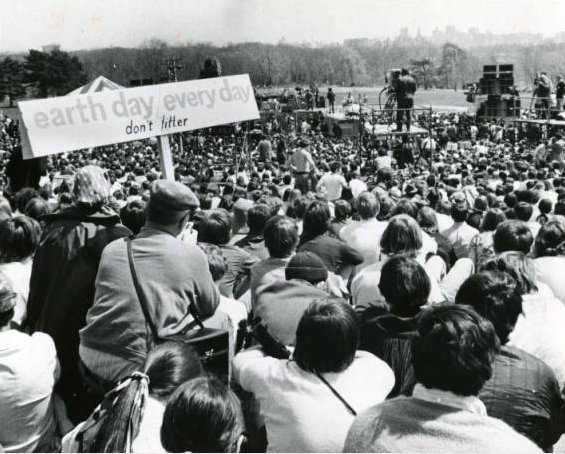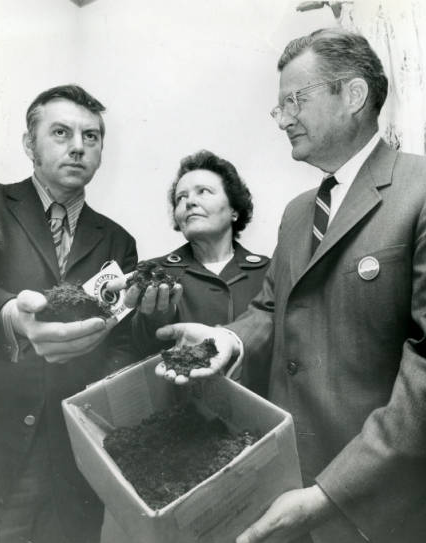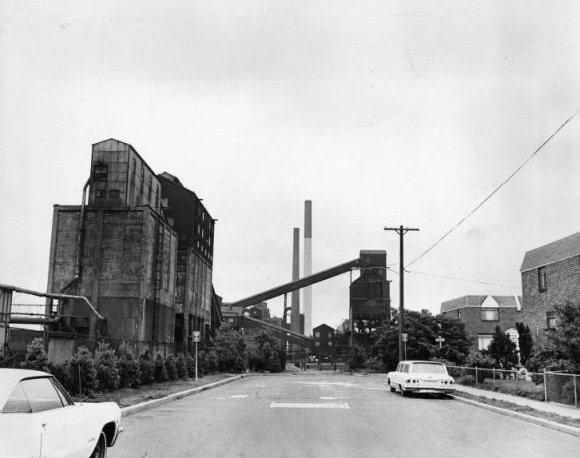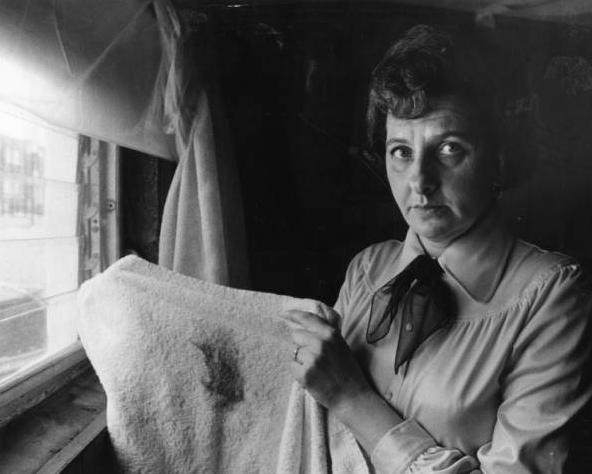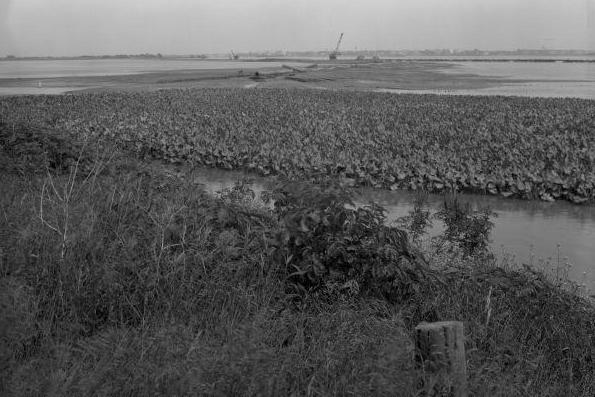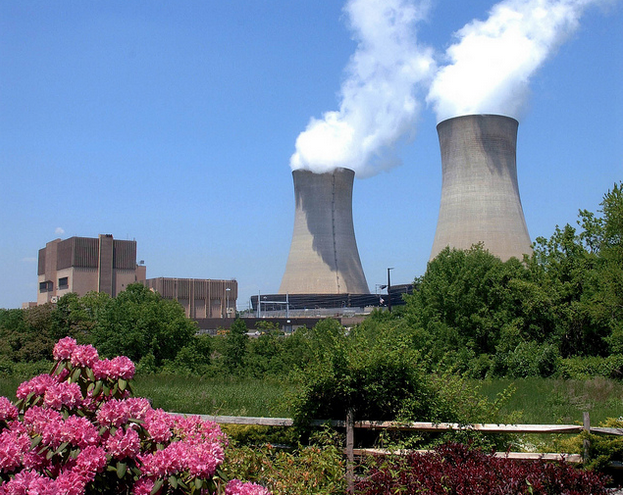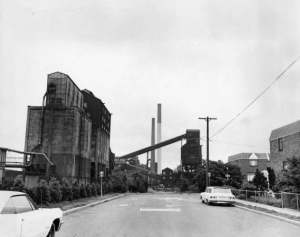Environmental Movement
Essay
With its industrial past and expanses of natural resources, the Greater Philadelphia region teemed with activity during the environmental movement of the late twentieth and early twenty-first centuries. In the years following World War II, people across the United States began to demand new measures to assure their health and safety. The resulting environmental movement, a diverse yet collaborative effort on the local and national levels, sought to protect the natural environment from the harmful effects of industrialization, new technologies, and suburbanization.
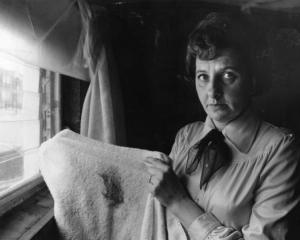
Philadelphia’s smelting plants, chemical producers, and oil refineries contributed to the region’s economic well-being, but these industries and other manufacturing interests generated a large amount of air and water pollution. It was not uncommon to see chimneys bellowing smoke and heaps of discarded coal around Philadelphia. Reflecting the extent of the problem, in 1970, two Bridesburg homemakers posted a sign outside of the Philadelphia Coke Co. that read “Welcome to Pollutionburg.”
The regional nature of the pollution problem spurred regional responses in the form of both federal initiatives and grassroots organizing. The federally mandated Delaware River Basin Commission (DRBC), founded in 1961, sought to abate water pollution in the Delaware River, especially in the eighty five miles between Trenton and Wilmington, and to protect wildlife. A nonprofit organization founded in 1958, the Pennsylvania, New Jersey, Delaware Metropolitan Project Inc. (PENJERDEL), also tackled environmental problems regionally by offering environmental research grants in the eleven-county area from Trenton to Wilmington. For example, a 1961 grant to Drexel Institute of Technology supported the study of air pollution in all three states. Regional action at the grassroots level included the 1967 founding of the Delaware Valley Citizens Council for Clear Air by the Pennsylvania, New Jersey, and Delaware Tuberculosis and Health Associations. Seeking a regional solution to air pollution, the council sponsored pollution awareness events like Cleaner Air Week throughout the 1960s and 1970s.
Universities and Earth Week 1970
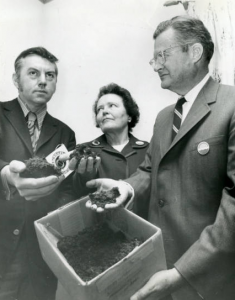
In keeping with the development of ecological science (the study of interactions among organisms and their environment), local universities and scientific institutions played vital roles in Philadelphia-area environmentalism. For example, Academy of Natural Sciences limnologist Ruth Patrick (1907-2013) was a pioneer in environmental ecology. Her work in freshwater ecosystems promoted scientific understanding of pollution’s effects on streams and helped to promote further pollution research. Chestnut Hill resident Ian Lennox McHarg (1920-2001) incorporated the study of ecology into the curriculum of the University of Pennsylvania’s Department of Landscape Architecture and Regional Planning during his tenure as chair (1955-86). His lecture series “Man and the Environment” helped to publicize the scientific exploration of the human relationship with nature and his book, Design with Nature, had a far-reaching influence on ecological sensibility.
McHarg also influenced a generation of ecologically conscious students. In 1970, students in McHarg’s department spread the idea of an environmental consciousness by joining in a nationwide environmental teach-in, Earth Day. Not satisfied with just one day, students planned an entire week of activities and called this Earth Week. Earth Week focused on ecological awareness, involvement, and action. Activities at Philadelphia-area universities included an Environmental teach-in committee of Temple University and speakers at Swarthmore College, Villanova University, and the University of Pennsylvania.
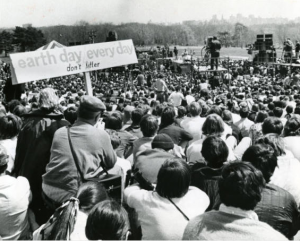
Students and universities in the region played an important role in spurring public consciousness about ecological issues before, during, and after Earth Week. In March 1970, the Philadelphia Ecology Action Group sponsored a daylong environmental teach-out at Drexel University. During Earth Week, student members of the organization helped with a “pollution trail” bus tour that carried more than five hundred tourists on ten buses to see the region’s biggest polluters, smelting plants, and the Philadelphia incinerator. Students from Philadelphia College of Art created ecological-awareness art for the event. Although not as large at the 1970 event, Earth Week continued to educate people about the environment into the 1990s, and Earth Day continued to be observed in the region in the twenty-first century.
Fighting for Safer and Cleaner Communities
In the decade following the first Earth Week, additional environmental organizations formed throughout the region. In New Jersey in 1974 citizens in Logan Township, Gloucester County, formed Citizens Organization for Logan Township Safety (COLTS) to oppose a proposed liquefied natural gas terminal. Stating safety as their main concern, the local citizen group, along with state agencies in New Jersey, Pennsylvania, and Delaware, staunchly opposed the terminal until its cancellation in 1976. Not all groups met with success. In the summer of 1973 a Montgomery County, Pennsylvania, environmental group, Stop the Oil Pipeline Society (STOPS), tried but failed to halt the construction of an eighty-mile pipeline that would run through Chester, Montgomery, and Bucks Counties. In 1974, Open Space Inc., a group based in New Hope, Bucks County, lobbied the state to stop aerial spraying of pesticides to combat gypsy moths because of the harmful health effects of the pesticide DDT. Although unsuccessful in halting spraying, Open Space helped to publicize the controversy over harmful pesticides like DDT.
Many community-based environmental groups opposed industrial dumping of hazardous waste. The Eastern Pennsylvania Group of the Sierra Club, the loudest adversary of the improper disposal of hazardous waste in Philadelphia throughout the 1970s and 1980s, continuously fought to reduce dumping of toxic chemicals that could infiltrate public water sources. In South Jersey, the Stop Ocean Dumping Association (SODA) engaged in legal action to stop Pennsylvania industries from dumping waste in Cape May County. The group argued the dumping not only spoiled the scenic beauty of the area but also adversely affected the fishing and tourism industry.
In the 1980s, landfills, especially those that were dumping grounds for industrial waste, proved the biggest offender to environmental sensibility. Throughout the 1980s and 1990s, the Environmental Protection Agency (EPA) assisted in the effort to clean up hazardous waste in the area, designating more than two hundred Superfund sites in the Greater Philadelphia region. Examples of these sites include the Lipari Landfill in Pitman, New Jersey; Strasburg in Coatesville, Pennsylvania; and Moyer’s in Eagleville, Pennsylvania. The EPA also designated brownfields, contaminated sites less severe than Superfund sites, that still warranted support in clean up.
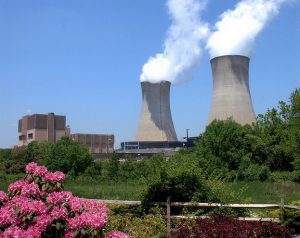
Environmental groups were also concerned with the nuclear industry. One of the earliest anti-nuclear environmental groups in Philadelphia was a local chapter of the national movement Women Strike for Peace. Formed in the early 1960s, the Philadelphia chapter lobbied against the adverse health and environmental effects of nuclear weapons testing. In the 1970s, anti-nuclear activists changed their focus to the dangers of nuclear power plants. In the Philadelphia region, the group Keystone Alliance led the charge to temporarily halt construction of a nuclear power plant in Limerick, Montgomery County. Joined by the groups Limerick Ecology Action and the Environmental Coalition on Nuclear Power, the action stopped construction until an environmental impact study could be completed. Although one nuclear power plant was constructed in Limerick, another planned plant was discontinued.
Protecting Natural Landscapes
In the 1970s, following the post-World War II boom of new suburban housing tracts, shopping malls, and highways, local organizations mobilized to protect the environment and remaining open spaces, including local watersheds. Philadelphia activists formed the Save the Wissahickon Committee and the Pennypack Watershed Association. In Delaware County, residents formed the Concerned Area Residents for the Protection of Tinicum Marsh (CARP) in 1972 and secured congressional legislation to protect the largest remaining freshwater tidal wetland in Pennsylvania, which became the nation’s first urban wildlife refuge, the John Heinz National Wildlife Refuge at Tinicum.
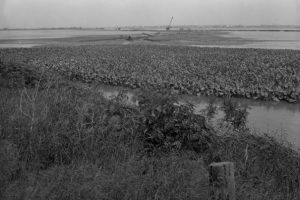
In South Jersey in 1978, local, state, and national conservation groups including the Audubon Society and the West Jersey Group of the Sierra Club organized under the umbrella of the Pine Barrens Coalition. Backed by expert testimony, including soil experts from Rutgers University, the coalition successfully lobbied in Trenton and Washington for the passage of the Pinelands Protection Act. The act restricted development within the complex ecosystem. The Pine Barrens Coalition (later the Pinelands Preservation Alliance) served as a watchdog to ensure the act was enforced and the Pine Barrens preserved.
New Jersey had a history of commitment to preserving open spaces exemplified in the passage of the Green Acres Program in 1961. From 1961 to 1995, New Jersey voters approved $1.4 billion in Green Acres bonds to protect open spaces. Support for these programs was clear in 1998 when voters approved a referendum to use tax revenues to protect natural landscapes for the next thirty years. By 2017, the Green Acres Program had protected more than 650,000 acres of open space in New Jersey.
Environmental Justice: Beyond the Environmental Movement
Throughout the 1980s, people began to realize that hazardous environmental conditions disproportionately affected predominately poor and minority communities. Efforts to correct these injustices took the form of campaigns for environmental justice, characterized by collaboration between community members and legal advocates, to ensure that environmental regulation would apply to all people regardless of race, national origin, or income.
The Public Interest Law Center of Philadelphia, founded in 1969, became involved in many environmental justice cases in the region, including two high-profile cases in Chester, Pennsylvania, and Camden, New Jersey. Both locales had predominately low-income minority communities and disproportionate numbers of hazardous waste facilities compared to their surrounding counties. In Chester, residents complained that the white residents of Delaware County unfairly used their community as a “toxic wasteland.” In 1993, The Public Interest Law Center worked with Chester Residents Concerned for Quality Living (CRCQL) to challenge a proposed infectious medical waste sterilization facility on the grounds of civil rights, the first case to do so. In 1995 the Pennsylvania Supreme Court forced the plant to close.
In Camden, the 686-acre Waterfront South neighborhood alone was home to four junkyards, numerous heavy industrial companies, and a petroleum coke transfer station. In 1999, South Camden Citizens in Action (SCCIA), with the help of the Public Interest Law Center in Philadelphia, took legal action against the St. Lawrence Cement Company. They won an injunction halting construction of a cement plant that would have caused extensive pollution. Although the injunction was overturned and the plant eventually built, the case raised awareness of environmental injustices suffered by communities like Camden. Community groups like the Center for Environmental Transformation, founded in 2005, continued to work closely with residents and organizations as agents of environmental justice.
The fight for environmental justice continued into the twenty-first century. In 2012, the Public Interest Law Center collaborated with the Eastwick Friends and Neighbors Coalition in Philadelphia to stop development of an apartment complex that would have adversely affected the health and safety of the neighborhood. The groups successfully convinced the developers to work toward a project with community-based planning. In 2016 PennEnvironment, a statewide, citizens environmental advocacy organization, released a study publicizing the disproportionate threat posed to low-income communities in Philadelphia from the pollution and potential derailments of oil trains. Dangerous derailments in the region in 2014 and 2015 brought the issue to a forefront.
The Greater Philadelphia region typified citizen engagement with diverse environmental issues after World War II employing regional, grassroots, and institutional approaches. The expansion of an environmental consciousness continued into the twenty-first century. While some groups focused on familiar issues like pollution, green spaces, and waste, the turn of the century also brought new concerns over climate change and hydraulic fracking. Advocacy groups such as PennEnvironment and the Pennsylvania Environmental Council approached these issues at a statewide level. Others have focused on the grassroots. In 2012, students at Swarthmore College and the University of Pennsylvania were instrumental in starting a national movement towards fossil fuel divestment to combat climate change. Philadelphia-based Earth Quaker Action Team, founded in 2010, called attention to the devastating effects of mountaintop removal coal mining and the Keystone XL Pipeline. Many organizations active during the earlier environmental movement endured, expanding their goals to face new problems. In the years after World War II, local citizens made great strides toward a cleaner and healthier region.
Alexandra L. Straub is a Ph.D candidate in History at Temple University, where she studies American environmental history. (Author information current at time of publication.)
Copyright 2017, Rutgers University
Gallery
Backgrounders
Connecting Headlines with History
- Earth Day exhibit inspired by nature at Penn Charter School (WHYY, April 22, 2013)
- Celebrating Earth Day with a solar farm stand in Philly (WHYY, April 22, 2014)
- Earth Day pollution prevention through good housekeeping (WHYY, April 22, 2014)
- Point Pleasant to celebrate Earth Day this Saturday (WHYY, April 21, 2015)
- Influencing the Environment (WHYY, October 21, 2016)
- Delaware releases report of chemicals released into environment (WHYY, February 8, 2017)
- N.J. film festival highlights the risk takers in the environmental movement (WHYY, January 20, 2014)
- Hundreds of youth climate strikers surround City Hall (WHYY, September 20, 2019)
